Click here to download the Synopsis
Q.1) On the outline map of India, mark the location of all the following. Write the significance of these locations, whether physical/commercial/economic/ecological/ environmental/cultural, in not more than 30 words for each entry.: (2 x 5 =10 marks)
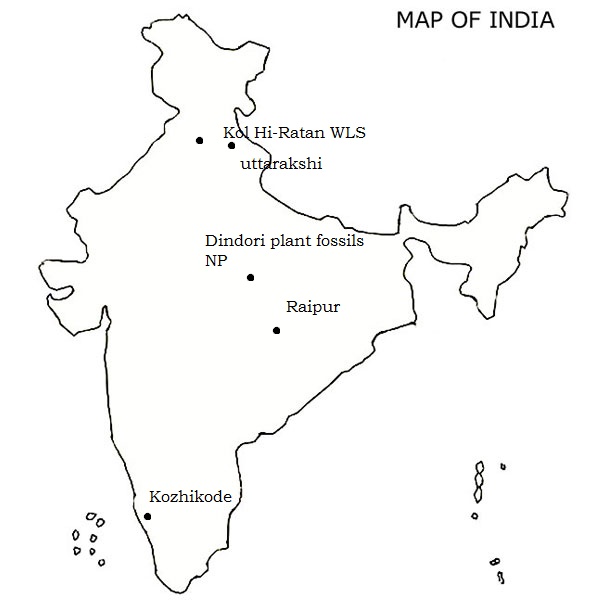
Uttarkashi, meaning Kashi of the north, is a town in Uttarakhand, India. Uttarkashi(uki) means the Kashi of North and is also known as Somya Kashi. Uttarkashi is a very religious place for tourism. It has also become famous among adventurous people due to the scope of various adventurous activities. Uttarkashi town is also called as Shivnagri. Uttarkashi town has number of temples and ashrams. Uttarkashi is known for its religious people, weather, education and fashion.
Dodital: One of the popular fresh water lake in Uttarkashi. 21 km trek to Dodital starts from Sangamchatti.
Raipur is a city in Raipur district in the Indian state of Chhattisgarh. It is the largest city and the capital of Chhattisgarh. It was formerly a part of Madhya Pradesh before the state of Chhattisgarh was formed on 1 November 2000.
Raipur is located near the centre of a large plain, sometimes referred as the “rice bowl of India”, where hundreds of varieties of rice are grown. The Mahanadi River flows to the east of the city of Raipur, and the southern side has dense forests. The Maikal Hills rise on the north-west of Raipur; on the north, the land rises and merges with the Chota Nagpur Plateau, which extends north-east across Jharkhand state. On the south of Raipur lies the Deccan Plateau.
Kozhikode, also known as Calicut, is a city in Kerala, India and the headquarters of the Kozhikode district.
During classical antiquity and the Middle Ages, Kozhikode was dubbed the City of Spices for its role as the major trading point of Indian spices. It was the capital of an independent kingdom ruled by the Samoothiris (Zamorins) in the Middle Ages and later of the erstwhile Malabar District under British rule. Arab merchants traded with the region as early as 7th century, and Portuguese explorer Vasco da Gama landed at Kozhikode on 20 May 1498, thus opening a trade route between Europe and Malabar.
Khol Hi-Raitan Wildlife Sanctuary is situated in Panchkula district of Haryana State, India.
The wild species include Indian leopard, Asiatic elephant, Chital (spotted deer), Sambar deer, Wild boar, Rhesus macaque, Gray langur, Striped hyena, Indian jackal, Jungle cat, Indian gray mongoose, Indian fox and Indian jackal.
Dindori Plant Fossils National Park is situated in Dindori district of Madhya Pradesh in India. This national park has plants in fossil form that existed in India anywhere between 40 million and 150 million years ago spread over seven villages of Dindori District (Ghuguwa, Umaria, Deorakhurd, Barbaspur, Chanti-hills, Chargaon and Deori Kohani).
Interspersed with the plant fossils are to be found the fossils of molluscs. One theory is that the area in which the fossils are located, i.e., the Narmada Valley near Mandla, was actually a deep inundation of the sea into peninsular India until the Post- Cambrian Tertiary age, about 40 million years ago. This means that Narmada was a very short river which terminated in the inland sea above Mandla, and that the recession of the sea caused geological disturbances, which created the present rift valley through which the Narmada River and Tapti River flow in their present journey to the Arabian Sea. All this, however, is speculation and conjecture because it is only recently that an interest has developed in the fossils of Mandla and detailed scientific studies are still wanting.
Q.2) Explain the following terminologies in about 50 words each: (5 x 5 =25 marks)
- Terrigenous materials
Terrigenous sediments are those where the ultimate source is weathering and erosion of rocks on land. The materials composing these sediments are introduced to the ocean by water, wind or ice. Terrigenous sediments are more abundant close to the continents, specifically, near river mouths and in the very deep areas of the oceans.
The composition of terrigenous sediments thus depends on the climate and weathering at the source region, and the distribution of these sediments by the geographic deposition of rivers and the prevailing winds.
- Pelagic matter
Pelagic sediment or pelagite is a fine-grained sediment that accumulates as the result of the settling of particles to the floor of the open ocean, far from land. These particles consist primarily of either the microscopic, calcareous or siliceous shells of phytoplankton or zooplankton; clay-size siliciclastic sediment; or some mixture of these. Trace amounts of meteoric dust and variable amounts of volcanic ash also occur within pelagic sediments. Based upon the composition of the ooze, there are three main types of pelagic sediments: siliceous oozes, calcareous oozes, and red clays.
- Red clay
The inorganic material making up pelagic deposits consist mainly of red clay that usually originates from volcanic activity. Red clay is mainly made up of silicon and aluminum dioxide, while the other constituents can include radium, phosphorous manganese and iron. Red clay comprises the most widely distributed specific pelagic deposit and covers more than half of the total ocean floor in the Pacific Ocean (Samiksha S. , 2016).
- Spring tides
Tides are a result of gravitational pull by both Sun and Moon, but the pull exerted by Sun is apparently weak. This is because of the larger distance as the gravitational force is inversely proportional to the square of the distance. The alignment of Sun and moon affects the size of the tides.
At spring tide, Sun, Moon and Earth are in a line. This occurs on new moon and full moon. When there is greatest variation between the high tides and low tides, it is called Spring Tides. Gulf of Fundy is known for highest tides in the world.
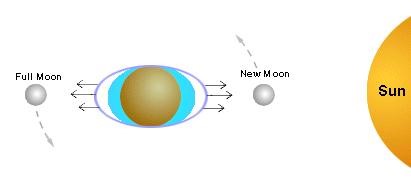
- Tidal bores
A tidal bore occurs along a coast where a river empties into an ocean or sea. A tidal bore is a strong tide that pushes up the river, against the current. A tidal bore is a true tidal wave.
A tidal bore is a surge. A surge is a sudden change in depth. When a channel suddenly gets deeper, it experiences a positive surge. When a channel suddenly gets shallower, it experiences a negative surge. Tidal bores are positive surges.
Read more about tidal bores here (from prelims perspective)
Q.3) Describe the characteristics of different types of pelagic deposits. (2015) (20 marks)
Approach
- Define pelagic deposit in the introduction.
- Explain each of the pelagic deposits and its characteristics
- Draw the distribution of pelagic matter in ocean waters.
- Conclude
Answer
Pelagic deposits consist of matter derived from algae and are mostly in the form of liquid mud, generally known as ooze. Pelagic materials are oozes which are divided into two groups on the basis of lime and silica contents as follows.
(i) Calcareous oozes contain lime content in abundance and are seldom found at greater depth because of their high degree of solubility. They are generally found at the sea floor between the depths ranging from 1500 meters to 4000 meters. On the basis of principal organisms’ calcareous oozes are further divided into two sub-types viz, (a) pteropod ooze and (b) globigerina ooze.
(a) Pteropod Ooze- Most of the pteropod oozes are formed of floating pteropod molluscs having thin shells. It contains 80 per cent calcium carbonate and is mostly found in the tropical oceans and seas at the depth of 600 meter to 2000 meter it decreases with greater depths and practically disappears beyond 3500 meters depth. It is found mostly in the regions of corals.
The main location of pteropod ooze includes the western and eastern parts of the Pacific Ocean, surroundings of Azores, Canary Island, Antilles, mid-Mediterranean ridge -and Indian Ocean.
(b) Globigerina Ooze- Though this ooze is formed from the shells of a variety of foraminifera but most of such oozes are formed of germs called globigerina. When this deposit is dried up it becomes dirty white powder. Besides milky white colour, it is also blue, grey, yellow and green in colour.
The chemical composition reveals 64.46 percent of calcium, 1.64 percent of silica and 3.33 percent of minerals. Globigerina is found mostly in the tropical and temperate zones of the Atlantic Ocean, on the eastern and western continental shelves of the Indian Ocean and in the eastern Pacific Ocean.
It is generally found between the depths of 3500 meters to 7500 fathoms and becomes absent at greater depths.
(ii) Siliceous Ooze- When silica content dominates, the ooze becomes siliceous in nature. Silica is derived from a group of protozoa or radiolarians and benthic animals mainly sponges. This Ooze does not dissolve as compared to calcareous ooze because of less calcium carbonate and dominance of silica. Thus, such oozes are found in both warm and cold water at greater depths. This group is further divided into two subtypes on the basis of dominance of a particular organism.
(a) Radiolarian ooze is formed by the shells Of Radiolaria and foraminifera. It changes to dirty grey powder when dried. Silica predominates but calcium carbonate is also present (ranging between 5 to 20 percent, average being 4 percent). Lime content decreases with increasing depth and it absolutely disappears at greater depth. This ooze is found up to the depth of 3500 meters to 9500 meters in the tropical oceans and seas. It covers the largest areas in the Pacific Ocean.
(b) Diatom ooze is formed of the shells of very microscopic plants containing silica in abundance. It also contains some clay. Calcium content varies from 3 to 30 percent. It is blue near the land and the colour changes yellow or cream away from the land. It becomes fine coherent white powder when dried. Diatom ooze is very frequently found at greater depth in high latitudes.
Significant area of this deposit includes the zone around Antarctica and a belt from Alaska to Japan in the N. Pacific at the depth of 1000 to 3500 meters.
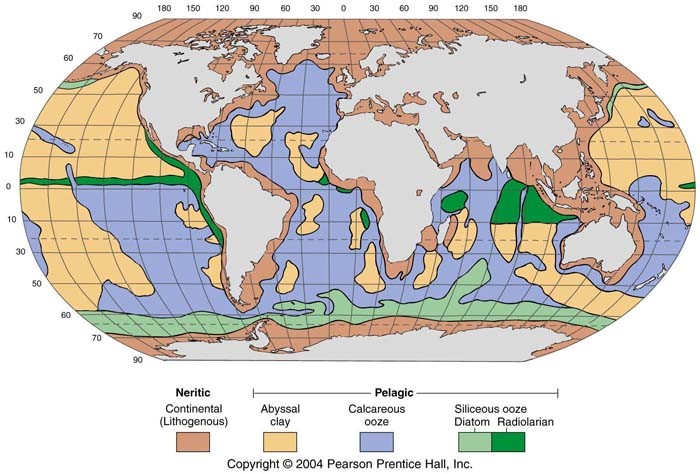
Red clay, previously considered to be of organic origin, is the most significant inorganic matter and very important member of pelagic deposits. It covers the largest area of deep-sea deposits. Silicates of alumina (85.35 percent) and oxides of iron are the chief constituents besides, calcium (6.7 per cent), siliceous organisms (2.39 per cent) and a few minerals are also present. It also contains It may be pointed out that red clay contains more radioactive substances than any other marine deposit. It is soft, plastic and greasy in character. It becomes reddish brown powder when dried. Red clay is widely distributed at the greatest depth in all the oceans. Its dominant locations include the zone between 40-degree N and 40 S in the Atlantic the North Pacific Ocean.
Q.4) “The relationship between the winds and the currents is best seen in the Indian Ocean.” Justify. (2016) (15 marks)
The current systems of the Indian Ocean are largely controlled and modified by landmasses and monsoon winds. Indian Ocean being surrounded by the Indian subcontinent. Africa and Australia do not present most favorable conditions for the development of permanent and consistent system of ocean currents. The currents in the northern Indian Ocean change their flow direction twice a year due to north-east and south-west monsoon winds.
During winter the wind blows from land to sea. And this N-E monsoon wind also drives the ocean currents in the northern gyre of Indian ocean currents.
(1) North-east Monsoon Current (Warm)
North-east monsoon winds blow from land to the ocean during winter season in the northern hemisphere and thus westward blowing north-east monsoon currents are produced between Andaman and Somali (figure 4.1). This current flows to the south of 5-degree N latitude. Besides, some independent currents originate in the Bay of Bengal and Arabian sea and flow in south-westerly direction.
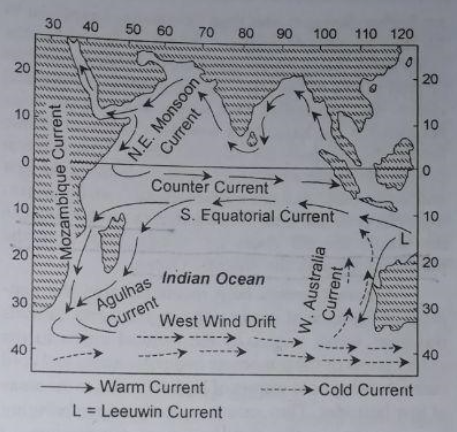
Figure 4.1 Indian ocean currents during winter.
(2) Indian Counter Current (warm)
Indian counter current is originated during winter season (northern hemisphere). This current flows in easterly direction between 2 deg. -8 deg. S latitudes from Zanzibar to Sumatra.
(3) S.W. Monsoon Current (warm)
There is complete reversal in the direction of monsoon winds during summer season. In other words, north-easterly direction of winter monsoon winds becomes south-westerly during summer season in the northern hemisphere. This reversal of direction of monsoon winds also reverses the direction of ocean currents Indian Ocean during summer Season.
North- east monsoon ocean currents disappear, and south-west monsoon ocean currents are developed. The general direction monsoon currents is from south-west to north-east (fig 4.2) but several minor branches emerge from the main branch and move in the Bay of Bengal and Arabian Sea. The Indian counter current developed during winter season disappears due to this current.
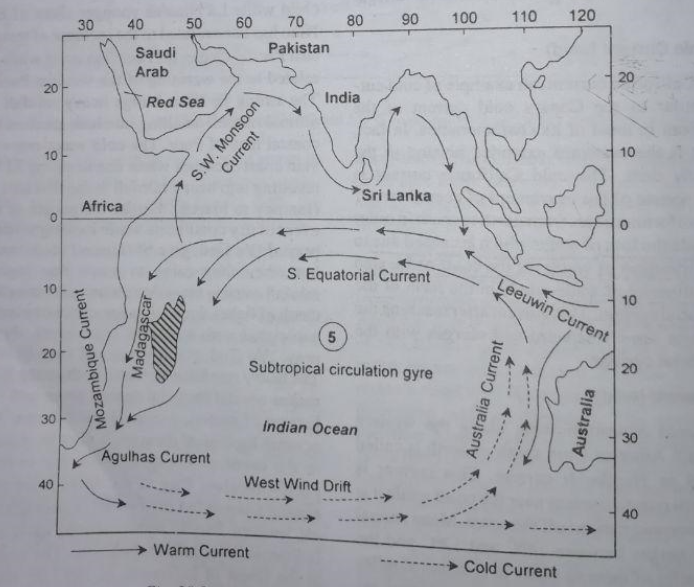
Figure 4.2 Indian ocean currents during Summer
The ocean currents of subtropical circulation gyre viz. South equatorial current, Mozambique current, Australian current are least affected by the wind system and almost remains same during both S-W monsoon and N-E monsoon.
(4) West Wind Drift (cold)
Like Pacific and Atlantic Oceans eastward flowing current, known as west wind drift, is also generated in the Indian Ocean, this current is produced due to eastward blowing westerlies along 40-degree N latitude known as ‘roaring forties’.
This current bifurcates in two branches near 110 deg. E longitude. One branch turns north- ward and flows as West Australia Cold current along the western coast of Australia and near the Tropic of Capricorn turns towards west and north-west and ultimately merges with the south equatorial current near longitude. The second branch Of the West wind drift turns southward.
Q.5) What is demographic dividend and its current scenario in India? What are the challenges in Skill Ecosystem and measures taken by government of India? (15 marks)
Reference
Yojana September 2018 magazine
Approach
- Define demographic dividend in introduction
- Explain its current scenario in India.
- Mention the challenges in skill ecosystem
- Government measures take to overcome these challenges
Answer
Demographic dividend is “the economic growth potential that can result from shifts in a population’s age structure, mainly when the share of the working-age population (15 to 64) is larger than the non-working-age share of the population (14 and younger, and 65 and older)”. In other words, it is “a boost in economic productivity that occurs when there are growing numbers of people in the workforce relative to the number of dependents.”
India is passing through a demographic transition which makes India the youngest nation in the world with the average of 29 years.
This offers India a unique opportunity to provide skilled manpower not only to the rapidly growing domestic economy but also to the ageing economy of the west.
India currently with around 28 percent population in the youth category is witnessing an increase in its working age population which may saturate by 2040.
There is a large heterogeneity among the states in their demographic profile and evolution. The southern state may cross over the demographic dividend faster than the north Indian states.
The India Skills Report 2018, brought out by Wheebox, indicates that only 46 percent of youth coming out of higher educational institutes are employable.
Challenges in Skill Ecosystem
- Large pool of educated youth.
- High demand for skilled manpower vis-a-vis low employability.
- Skilling formal school dropouts to provide them second chance to acquire basic numeracy, literacy and functional skills for accessing jobs in the formal sector.
- Limited and unequal distribution of training capacities vis-a-vis youth demographics.
- Availability of good quality trainers due to lack of focus on development on trainers’ training programs and career progression pathways for them.
- Multiplicity in assessment and certification systems leading in inconsistent outcomes and confusion to the employers.
- Preponderance of informal / unorganized sector and mapping of existing skills and skills required.
- Achieving convergence and coordination across sectors.
Measures taken by GOI in this regard
Over the years, changes in the macro environment, and the experience gained through implementation of various skill development programmes in the country have necessitated changes in the policy. Accordingly, the National Skill Development Policy, 2015 was formulated, and it supersedes the Policy of 2009.
The 2015 National Policy on Skill also recognizes the value of on the job training, by making apprenticeships in actual work environments an integral part of all skill development efforts.
National Labour Market Information System (LMIS), was launched which is an integrated set of institutional arrangements, procedures, mechanisms and data systems designed to produce labour market information as per global standards and best practices.
The inputs from 21 ministries, State Governments, National Skill Development Corporation and Sector Skill Councils is underway to be integrated in the national database on skilling.
Another initiative of the Ministry leveraging technology to reach millions of skill seekers, was the launch of India Skills Online (www.indiaskillsonline.com), an online platform for learning skills of choice.
With the introduction of Online Skill learning environment, the whole nation potentially becomes a classroom. The audio-video graphical illustrations format will help internalize the concepts for the skill-seekers, faster and longer.
India Skills is a national competition steered by Ministry of Skill Development & Entrepreneurship (MSDE) and National Skill Development Corporation (NSDC) to select the best talent who will lead India’s participation at the biennial World Skills International Competition.
Further, a system of concurrent monitoring through SMART portal has been introduced for maintaining quality of training.
A user-friendly online portal (www.apprenticeship.gov.in ) has been launched in order to facilitate the easy processing of entire apprenticeship cycle and for effective administration and monitoring.
For the first time, graduation ceremonies are held at ITIs and skill centres to award certificates.
The Kaushal melas are organized for motivating youths and their communities to make skill as an alternative career option.
